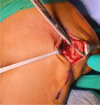Clinical insights into traumatic injury of the inferior alveolar and lingual nerves: a comprehensive approach from diagnosis to therapeutic interventions
- PMID: 38488908
- PMCID: PMC10942925
- DOI: 10.1007/s00784-024-05615-4
Clinical insights into traumatic injury of the inferior alveolar and lingual nerves: a comprehensive approach from diagnosis to therapeutic interventions
Abstract
Objectives: This scoping review explores the risk and management of traumatic injuries to the inferior alveolar and lingual nerves during mandibular dental procedures. Emphasizing the significance of diagnostic tools, the review amalgamates existing knowledge to offer a comprehensive overview.
Materials and methods: A literature search across PubMed, Embase, and Cochrane Library informed the analysis.
Results: Traumatic injuries often lead to hypo-/anesthesia and neuropathic pain, impacting individuals psychologically and socially. Diagnosis involves thorough anamnesis, clinical-neurological evaluations, and radiographic imaging. Severity varies, allowing for conservative or surgical interventions. Immediate action is recommended for reversible causes, while surgical therapies like decompression, readaptation, or reconstruction yield favorable outcomes. Conservative management, utilizing topical anesthesia, capsaicin, and systemic medications (tricyclic antidepressants, antipsychotics, and serotonin-norepinephrine-reuptake-inhibitors), proves effective for neuropathic pain.
Conclusions: Traumatic nerve injuries, though common in dental surgery, often go unrecorded. Despite lacking a definitive diagnostic gold standard, a meticulous examination of the injury and subsequent impairments is crucial.
Clinical relevance: Tailoring treatment to each case's characteristics is essential, recognizing the absence of a universal solution. This approach aims to optimize outcomes, restore functionality, and improve the quality of life for affected individuals.
Keywords: Anesthesia; Hypoesthesia; Life quality; Medication; Nerve injury; Neuropathic pain; Review; Trauma.
© 2024. The Author(s).
Conflict of interest statement
The authors declare no competing interests.
Figures







Similar articles
-
Assessing nerve injuries in oral surgery: a survey-based study on prevention and management.Med Oral Patol Oral Cir Bucal. 2025 May 1;30(3):e462-e468. doi: 10.4317/medoral.26995. Med Oral Patol Oral Cir Bucal. 2025. PMID: 40121682 Free PMC article.
-
Reconstructive Options for Inferior Alveolar and Lingual Nerve Injuries After Dental and Oral Surgery: An Evidence-Based Review.Ann Plast Surg. 2019 Jun;82(6):653-660. doi: 10.1097/SAP.0000000000001783. Ann Plast Surg. 2019. PMID: 30648997 Review.
-
Accuracy of MR neurography as a diagnostic tool in detecting injuries to the lingual and inferior alveolar nerve in patients with iatrogenic post-traumatic trigeminal neuropathy.Eur Radiol. 2024 Jul;34(7):4619-4627. doi: 10.1007/s00330-023-10363-2. Epub 2023 Dec 4. Eur Radiol. 2024. PMID: 38047973 Free PMC article.
-
Management of patients with trigeminal nerve injuries after mandibular implant placement.J Am Dent Assoc. 2002 Oct;133(10):1351-4. doi: 10.14219/jada.archive.2002.0050. J Am Dent Assoc. 2002. PMID: 12403537
-
The importance of a good evaluation in order to prevent oral nerve injuries: a review.Acta Odontol Scand. 2014 Apr;72(3):161-7. doi: 10.3109/00016357.2013.812746. Epub 2013 Jul 4. Acta Odontol Scand. 2014. PMID: 23822907 Review.
Cited by
-
Efficacy of Photobiomodulation Therapy Utilizing 808 nm and 660 nm Alone and in Combination for Treatment of Paresthesia in Rats.Biomedicines. 2024 Dec 30;13(1):65. doi: 10.3390/biomedicines13010065. Biomedicines. 2024. PMID: 39857649 Free PMC article.
-
Assessing nerve injuries in oral surgery: a survey-based study on prevention and management.Med Oral Patol Oral Cir Bucal. 2025 May 1;30(3):e462-e468. doi: 10.4317/medoral.26995. Med Oral Patol Oral Cir Bucal. 2025. PMID: 40121682 Free PMC article.
-
Dental recommendation and prescribing patterns for systemic analgesics - a cross-sectional study.Clin Oral Investig. 2025 Jul 14;29(8):383. doi: 10.1007/s00784-025-06403-4. Clin Oral Investig. 2025. PMID: 40658221 Free PMC article.
-
A comparative analysis of particulate bovine bone substitutes for oral regeneration: a narrative review.Int J Implant Dent. 2024 May 27;10(1):26. doi: 10.1186/s40729-024-00544-z. Int J Implant Dent. 2024. PMID: 38801622 Free PMC article. Review.
-
TRPV1-target drugs for the treatment of orofacial pain.Front Pharmacol. 2025 Apr 24;16:1568109. doi: 10.3389/fphar.2025.1568109. eCollection 2025. Front Pharmacol. 2025. PMID: 40343000 Free PMC article. Review.
References
-
- Van der Cruyssen F, Peeters F, Gill T, De Laat A, Jacobs R, Politis C, Renton T. Signs and symptoms, quality of life and psychosocial data in 1331 post-traumatic trigeminal neuropathy patients seen in two tertiary referral centres in two countries. J Oral Rehabil. 2020;47:1212–1221. doi: 10.1111/joor.13058. - DOI - PMC - PubMed
-
- Hölzle F, Riediger D and Ehrenfeld M (2012) Mikronervenchirurgie. In: Hausamen, Machtens, Reuther, Eufinger, Kübler and Schliephake (eds) Book title. Springer Verlag GmbH, Berlin, Heidelberg
Publication types
MeSH terms
LinkOut - more resources
Full Text Sources

